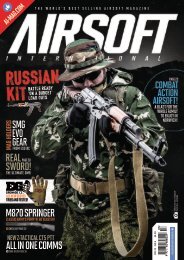Atheltics Weekly
You also want an ePaper? Increase the reach of your titles
YUMPU automatically turns print PDFs into web optimized ePapers that Google loves.
- Peta Bee,<br />
performance editor<br />
PERFORMANCE<br />
STARTING AFRESH<br />
MUCH criticism has<br />
been directed towards<br />
the current UKA and<br />
England Athletics coaching<br />
pathways since they<br />
were first implemented in<br />
2010. Courses that many<br />
perceive to be lengthy,<br />
expensive and far too<br />
general in terms of content<br />
have been widely cited as a<br />
reason for a decline in the<br />
numbers of new coaches.<br />
So, it will be interesting<br />
to see how the updated<br />
Athletics Coach<br />
qualification will be<br />
received following the<br />
initial pilot courses which<br />
commence in September.<br />
Unlike their predecessor,<br />
which required all<br />
prospective coaches to<br />
spend hours studying the<br />
intricacies of every event,<br />
the new set-up seems<br />
to offer the opportunity<br />
for earlier specialisation<br />
as you elect to focus on<br />
speed, throws, jumps or<br />
endurance.<br />
In other words, you<br />
won’t need to study the<br />
finer points of hurdle<br />
technique if your goal is<br />
to coach.<br />
PERFORMANCE<br />
GUIDE<br />
News round-up<br />
58 Sports science snippets<br />
60 Technique<br />
Learn the triple jump<br />
5 8 A T H L E T I C S W E E K L Y<br />
IOMECHANICS<br />
B<br />
researchers from<br />
Leeds Beckett<br />
University are to<br />
conduct the largest ever IAAFfunded<br />
project during the World<br />
Championships in London. Dr<br />
Athanassios Bissas, a principal<br />
lecturer in biomechanics, will<br />
lead a team of 40 people from<br />
the University’s Carnegie School<br />
of Sport in a study that will use<br />
40 cameras – including 25 highspeed<br />
cameras and 15 HD<br />
camcorders – to analyse<br />
performances in 17 different<br />
events. The team of analysts will<br />
work overnight to ensure a<br />
quick turnaround of the<br />
biomechanical assessments.<br />
For the sprints, video<br />
footage will be used to produce<br />
3D biomechanical data of<br />
variables such as stride length,<br />
stride frequency, ground<br />
contact times, joint angles and<br />
velocities and other important<br />
biomechanical variables while<br />
studies of distance runners<br />
will look at changes in fatigue<br />
during the 10,000m, foot-strike<br />
patterns in the marathon, and<br />
NEWS<br />
IAAF LAUNCHES MAJOR<br />
STUDY AT LONDON 2017<br />
TECHNICAL ASPECTS OF 17 EVENTS TO BE EVALUATED<br />
Technique analysed:<br />
40 cameras will record<br />
the action in London<br />
water jump hurdling technique<br />
in the steeplechase.<br />
The biomechanists will<br />
also be looking at velocities at<br />
various stages of the throwing<br />
events including release angles,<br />
release height, segmental<br />
coordination and other key<br />
factors while their analysis of<br />
jumping events will focus on<br />
take-off characteristics such as<br />
angles and velocities, approach<br />
kinematics, calculations of each<br />
phase in the triple jump, lean<br />
angles in the high jump, and<br />
approach velocity in the pole<br />
vault.<br />
Stage one of the IAAF<br />
funded biomechanics research<br />
project kicked off in June<br />
at the British Grand Prix of<br />
Race Walking 20km event<br />
in Roundhay Park, Leeds,<br />
which doubled as the British<br />
Team Trials for the IAAF World<br />
Championships.<br />
Dr Brian Hanley, a senior<br />
lecturer in Biomechanics at<br />
Leeds Beckett, was leading the<br />
trial on the walkers.<br />
GOOD RUNNERS MAKE BAD FIGHTERS<br />
IT’S LONG been proposed<br />
that you can achieve<br />
excellence in one aspect of<br />
athletic endeavour only at<br />
the expense of your aptitude<br />
for another. So it seems,<br />
at least in the case of<br />
laboratory mice.<br />
A study at the University<br />
of Utah has revealed that<br />
male mice better able to<br />
defend their territory through<br />
You’re a<br />
runner,<br />
not a<br />
fighter,<br />
study<br />
finds<br />
fighting off other males may<br />
have been stronger, but their<br />
running ability was lacking as<br />
they were found to burn more<br />
oxygen than less-successful<br />
fighters.<br />
Since humans also<br />
employ both endurancebased<br />
and aggression-based<br />
behaviours, the researchers<br />
suggested we are prone to<br />
similar trade-offs.<br />
MARK SHEARMAN






